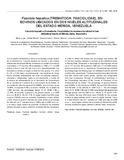Fasciola hepatica (trematoda: fasciolidae), en bovinos ubicados en dos niveles altitudinales del Estado Mérida, Venezuela

Visualizar/
Data
2018Autor
Palabras Clave
Fasciola hepatica, Bovinos, Altitud, Riesgo relativoFasciola hepatica, Bovines, Altitude, Relative risk
Metadatos
Mostrar registro completoResumo
Con el objetivo de detectar y valorar el porcentaje y riesgo relativo de la infección por Fasciola hepatica en bovinos a dos niveles
altitudinales del estado Mérida, Venezuela, se realizó un muestreo coprológico a 177 bovinos, 66 localizados a 1.000 y 111 a 2.000
metros sobre el nivel del mar (m.s.n.m.), respectivamente. Los animales se dividieron según la edad en tres grupos, = 2, entre
3 y 23, y = 24 (mes), respectivamente. Las muestras de heces fueron tomadas directamente del recto con guantes plásticos,
rotuladas y refrigeradas, hasta su procesamiento, a través de la técnica de sedimentación en el laboratorio de Parasitología
de la Facultad de Farmacia de la Universidad de los Andes. El porcentaje de infección general fue 33,89%: para el primer grupo
16,66%, el segundo 5,4% y el tercero 43,93%. En la altitud de 1.000 m.s.n.m., los porcentajes fueron 12,12; 16,66; 7,69; y
12,76%, de acuerdo al general y los grupos etarios; y a 2.000 m.s.n.m. 46,84; 0; 16 y 61,17%. El riesgo relativo fue 4,04 veces
superior (P=0,05) para los animales localizados a mayor altitud, y de 8,14 para el grupo = 24 (mes) de edad. Existe un porcentaje
de infección por F. hepatica leve a 1.000 y alto a 2.000 m.s.n.m., y un mayor riesgo relativo de presentar la infección los animales
adultos ubicados a mayor altitud en el estado Mérida, Venezuela.
Colecciones
Información Adicional
| Otros Títulos | Fasciola hepatica (Trematoda: Fasciolidae) in bovines localized in two altitudinal levels of Mérida state, Venezuela |
| Correo Electrónico | francisco.angulo@fcv.luz.edu.ve |
| Editor | SaberULA |
| ISSN | 0798-2259 |
| ISSN Electrónico | 2477-944X |
| Resumen en otro Idioma | In order to detect and assess the percentage and relative risk of Fasciola hepatica infection in bovines at two altitudinal levels in Merida State, Venezuela, a coprological sampling was carried out in 177 bovines, 66 located at 1,000 and 111 at 2,000 meters above sea level (m.a.s.l.), respectively. The animals were divided according to age into three groups: =2, between 3 and 23, and =24 month’s olds, respectively. The faecal samples were taken directly from the rectum with plastic gloves, labeled and refrigerated, until their processing, through of sedimentation technique in the Parasitology laboratory of the Faculty of Pharmacy of the Universidad de los Andes. The percentage of general infection was 33.89%, for the first group 16.66%, the second 5.4% and the third 43.33%. In the altitude of 1,000 m.a.s.l. the percentages were 12.12; 16.66; 7.69 and 12.76%, according to the general and the age groups; and at 2,000 m.a.s.l. 46.84; 0; 16 and 61.17%. The relative risk was 4.04 times more (P=0.05) for the animals located at higher altitude and 8.1 more to adults’ animals. There is a mild infection rate of F. hepatica at 1,000 and high at 2,000 m.a.s.l., and a higher relative risk to present of infection the adults animals localized to higher altitude in Mérida State, Venezuela. |
| Colación | 265-269 |
| País | Venezuela |
| Institución | Universidad del Zulia (LUZ) Universidad de Los Andes (ULA) |
| Publicación Electrónica | Revista Científica |





